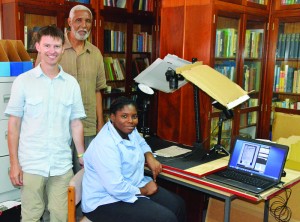
A number of important heritage and historical documents in Anguilla, which could have been lost forever due to deterioration and other factors, have now been preserved on a modern system of digital records.
The preservation of documents is part of a pilot project being undertakenby the Anguilla Archaeological and Historical Society in conjunction with the British Library.
The documents preserved so far include wills, deeds and court cases;early records on Sombrero; and all editions of The Beacon, Anguilla’s firstnewspaper,which chronicled events related to the Anguilla Revolution.
The recording equipment currently in use at the Heritage Room at the Anguilla Public Library is a high-resolution Digital Nikon Camera. It has two powerful lights at either side, is mounted on a table and is attached to a computer. The camerais suspended over the documents that are being photographed, and a connecting cable allows the digital photographs to be taken by the operator and stored on the computer’s hard drive.
The operator is Ms Anthea Roach, the Library Assistant, who has been specially-trained for that purpose. She is due to attend a workshop on document preservation at the National Library in Trinidad shortly.
Kenn Banks, President of the Anguilla Archaeological and Historical Society, explained how the project came into being. “We were able to receive a grant from the British Library under its Endangered Archives Project to fund a pilot project in Anguilla …for archival material,” he disclosed. “The British Library is mainly concerned with archival material before 1900 but, through this project, we were able to look at other endangered material in Anguilla. We were also able to look at old issues of The Beacon and other documents relating the Anguilla Revolution era which are not properly secured.
“Ben Jeff and Andy Pearson, who is the leader of the project, were in Anguilla for two months. They have been reviewing and photographing most of the material at the Library and Court House. The intention is to see whether there is enough material to come up with a larger project. They also provided the photographic equipment and computer hard drives for the projects which have been left with the Anguilla Archaeological and Historical Society, and which we have committed to the trust of the Library. Althea Roach, who is here with us, is the main custodian and she has been trained to use the equipment.”
Andy Pearson, an Archaeologist and Historian, stated in part: “The Endangered Archives Project or EAP effectually aims not to preserve the physical remains of documents. It is very much concerned with the danger itself to the material. So the main kind of work we have done has been firstly a survey to find out exactly what survives, where it is, including the Court House and Government; and then we went out in the communities to see what the private collections were – the main one being Heritage Collection Museum at East End. We spent a good deal of time photographing documents – digitalising them and creating a very large body of data. Each photograph was precisely set up and is of the highest possible quality we could have achieved. It is 30 megabytes per shot so you can image how that factors up with a book of 300 or 400 pages. The quality is so good that that we will never have to do it again.”
He said that researchers and other interested persons would now be able to access digital documents on computer screens by going to the appropriate websites to see the images posted by the British Library. “It means that what Anguilla has is going to be accessible to the public world-wide, “he observed.
Mr Pearson added: “We have only done a few documents – the main being the oldest surviving records existing on the island. Those are records from the 1740s through the 1790s. These are records of the ‘King’s Bench’ – wills, deeds and records of court cases. They don’t tell you much about governance but what they do, is give you some really good insights into Anguilla’s society and its economics. It is a very small collection but is valuable and tells stories about people – with the same surnames now of Gumbs and Richardson like back in those days.”








